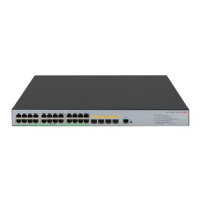402
To configure a C-RP:
Ste
Command
Remarks
1. Enter system view.
system-view N/A
2. Enter IPv6 PIM view.
pim ipv6 N/A
3. Configure an interface to be a
C-RP for IPv6 BIDIR-PIM.
c-rp ipv6-address [ { group-policy
acl6-number | scope scope-id } |
priority priority | holdtime
hold-interval |
advertisement-interval
adv-interval ] * bidir
No C-RP is configured by default.
Enabling embedded RP
With the embedded RP feature enabled, the router can resolve the RP address directly from the IPv6
multicast group address of an IPv6 multicast packets. This RP can replace the statically configured RP or
the RP dynamically calculated based on the BSR mechanism. Thus, the DR does not need to know the RP
address beforehand.
Perform this configuration on all routers in the IPv6 BIDIR-PIM domain.
To enable embedded RP:
Ste
Command Remarks
1. Enter system view.
system-view N/A
2. Enter IPv6 PIM view.
pim ipv6 N/A
3. Enable embedded RP.
embedded-rp [ acl6-number ]
Optional.
By default, embedded RP is
enabled for IPv6 multicast groups
in the default embedded RP
address scopes.
The default embedded RP address
scopes are FF7x::/12 and
FFFx::/12, where x refers to any
legal address scope. For more
information about the Scope field,
see "Multicast overview."
Configuring C-RP timers globally
To enable the BSR to distribute the RP-Set information within the IPv6 BIDIR-PIM domain, C-RPs must
periodically send C-RP-Adv messages to the BSR. The BSR learns the RP-Set information from the received
messages, and encapsulates its own IPv6 address together with the RP-Set information in its bootstrap
messages. The BSR then floods the bootstrap messages to all IPv6 routers in the network.
Each C-RP encapsulates a timeout value in its C-RP-Adv messages. After receiving a C-RP-Adv message,
the BSR obtains this timeout value and starts a C-RP timeout timer. If the BSR fails to hear a subsequent
C-RP-Adv message from the C-RP when the timer times out, the BSR assumes the C-RP to have expired or
become unreachable.

